Wikipedia:Picture of the day/June 2023
|
Featured picture tools: |
These featured pictures, as scheduled below, appeared as the picture of the day (POTD) on the English Wikipedia's Main Page in June 2023. Individual sections for each day on this page can be linked to with the day number as the anchor name (e.g. [[Wikipedia:Picture of the day/June 2023#1]] for June 1).
You can add an automatically updating POTD template to your user page using {{Pic of the day}} (version with blurb) or {{POTD}} (version without blurb). For instructions on how to make custom POTD layouts, see Wikipedia:Picture of the day.Purge server cache
June 1
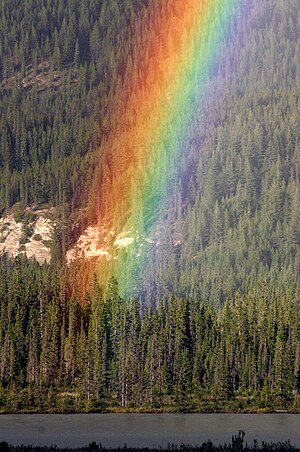
|
A rainbow is an optical phenomenon that can occur under certain meteorological conditions. It is caused by refraction, internal reflection and dispersion of light in water droplets resulting in a continuous spectrum of light appearing in the sky. The rainbow takes the form of a multicoloured circular arc. Although a rainbow spans a continuous spectrum of colours, it is traditionally assigned a discrete sequence, with red, orange, yellow, green, blue, indigo and violet as the most common list. The rainbow inspired the rainbow flag, a symbol of LGBT pride and Pride Month. This portion of a rainbow, appearing to rise from a lakeside forest, was photographed in 2005 in Jasper National Park in Alberta, Canada. Photograph credit: Wing-Chi Poon
Recently featured:
|
June 2

|
The western bowerbird (Chlamydera guttata) is a species of bird in the family Ptilonorhynchidae. The species is endemic to Australia, where it has a disjunct distribution, occurring in both Central Australia and the Pilbara region of Western Australia. It is 24 to 28 centimetres (9.4 to 11.0 in) in length with a mass of 120 to 150 grams (4.2 to 5.3 oz). The plumage is brown with reddish or buff spots over the throat, chest, neck, back head and wings, with a pink erectile crest on the nape. Its tail is brown, with the undersides buff. Males and females are similar in appearance, except that the tail of the female is slightly longer and it is more spotted on the throat than the male. This western bowerbird was photographed near Alice Springs in the Northern Territory in 2022. Photograph credit: John Harrison
Recently featured:
|
June 3

|
NGC 6530 is a young open cluster of stars lying around 4,350 light years from Earth in the constellation Sagittarius. The cluster is set within the larger Lagoon Nebula, a large interstellar cloud of gas and dust. This photograph of a portion of NGC 6530 was taken by NASA's Hubble Space Telescope released in 2022, with the Lagoon Nebula giving the image its smoky appearance. Photograph credit: ESA / Hubble / NASA / O. De Marco
Recently featured:
|
June 4
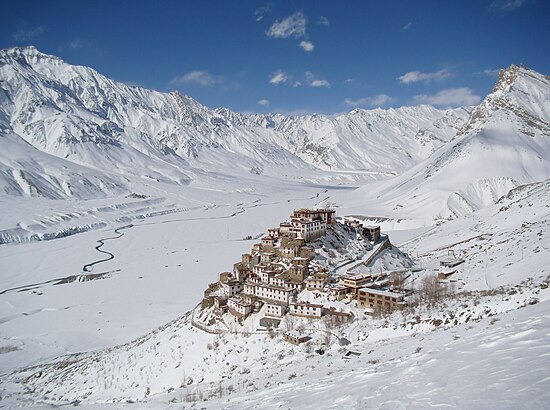
|
|
Key Monastery is a monastery belonging to the Gelugpa school of Tibetan Buddhism, located at an elevation of 4,166 m (13,668 ft) on a hill rising above the Spiti valley in the northern Indian state of Himachal Pradesh. Said to have been founded in the 11th century, it is the largest monastery in Spiti, housing hundreds of monks. This view shows the monastery in winter, overlooking the snow-covered Spiti river valley with the Himalayas in the background. Photograph credit: Kulbhushan Suryawanshi
Recently featured:
|
June 5

|
Clara McAdow (1838–1896) was an American women's suffragist and mine owner. Born in Ohio, she grew up in Jackson, Michigan, relocating to Montana with her first husband, C. E. Tomlinson. When Tomlinson died, she took their savings and invested in real estate in Billings. Through her real-estate ventures, she met her second husband, Perry McAdow. She purchased from him the Spotted Horse mine, which he had received as payment for a debt. Clara took charge of all aspects of the mine, directing all of its operations and often living on site. McAdow was intensely interested in the women's suffrage movement, hosting Carrie Chapman Catt and Susan B. Anthony in her home to promote giving women the vote. Photograph credit: unknown; restored by Adam Cuerden
Recently featured:
|
June 6

|
The Interior of the Palm House on the Pfaueninsel Near Potsdam is the title of two oil-on-canvas paintings by Carl Blechen, completed between 1832 and 1834. Both depict four odalisques as they relax in a palm house (which was destroyed by fire in 1880) at the royal retreat of Pfaueninsel near Berlin, but have different angles of view and compositions. The works were commissioned by King Frederick William III of Prussia and are now in the Hamburger Kunsthalle and the Art Institute of Chicago, with an 1832 color study for the work found in the Alte Nationalgalerie in Berlin. This picture shows the Chicago version of the painting, which was gifted by Frederick William to his daughter Alexandra Feodorovna, the wife of Emperor Nicholas I of Russia. It remained in the Russian imperial collection until around 1917, became part of a Swiss collection around 1920, and was owned by private collectors prior to its purchase by the Art Institute of Chicago in 1996. Painting credit: Carl Blechen
Recently featured:
|
June 7

|
Tenthredo scrophulariae, the figwort sawfly, is a species of insect in the family Tenthredinidae, found across Europe. The larvae are relatively large, with a length of 30 millimetres (1.2 in) and having 22 legs. They have a white body with black spots, and feed on mullein and figworts. They feed from August to September and emerge as adults in May the following year. This T. scrophulariae larva was photographed near Keila in north-western Estonia. Photograph credit: Ivar Leidus |
June 8

|
|
Ruddigore is a comic opera in two acts, with music by Arthur Sullivan and a libretto by W. S. Gilbert. It is one of the Savoy operas and the tenth of fourteen comic operas written together by Gilbert and Sullivan, and was first performed by the D'Oyly Carte Opera Company at the Savoy Theatre in London on 22 January 1887. The first night was not altogether a success, as critics and the audience felt that Ruddygore (as it was originally spelled) did not measure up to its predecessor, The Mikado. However, after it was revived by D'Oyly Carte in 1920, the work was reassessed more positively. This illustration was created by the British illustrator H. M. Brock for the 1921 revival of Ruddigore at the Prince's Theatre in London. Published in the October 29 issue of The Sphere, it depicts a scene from the opera in which the ghosts of Sir Ruthven Murgatroyd's ancestors step out of their picture frames and accuse him of not having committed a crime every day in accordance with the family curse. Poster credit: H. M. Brock; restored by Adam Cuerden |
June 9
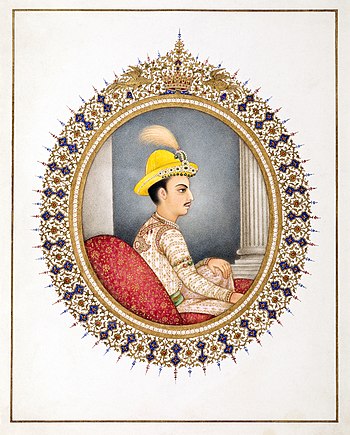
|
Girvan Yuddha Bikram Shah (1797–1816) was the fourth king of Nepal, ruling from 1799 to 1816. This drawing of the king was produced by an unknown artist around 1815 with opaque watercolor and gold on paper, and is now in the collection of the Los Angeles County Museum of Art. Illustration credit: unknown; restored by Captain Medusa |
June 10
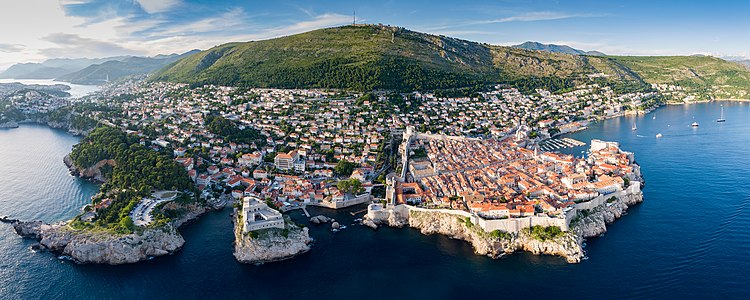
|
|
Dubrovnik, historically known as Ragusa, is a city in southern Dalmatia, Croatia, by the Adriatic Sea. A seaport and the centre of the Dubrovnik-Neretva County, it is one of the most prominent tourist destinations in the Mediterranean. Its total population is 41,562 as of the 2021 census. In 1979, the centre of the city was added to UNESCO's list of World Heritage Sites in recognition of its outstanding medieval architecture and fortified old town. This aerial panorama of Dubrovnik was taken in 2016. Photograph credit: Chensiyuan; edited by Bammesk
Recently featured:
|
June 11

|
|
The 1974 aluminum cent was a one-cent coin proposed by the United States Mint in 1973. Composed of an alloy of aluminum and trace metals, it was intended to replace the predominantly copper–zinc cent due to the rising costs of coin production in the traditional bronze alloy. None of the 1,571,167 coins struck were released into circulation. The coin depicted here was donated to the National Numismatic Collection at the Smithsonian Institution's National Museum of American History. Coin design credit: Victor David Brenner and Frank Gasparro; imaged by the National Numismatic Collection
Recently featured:
|
June 12

|
Ernest Rutherford (1871–1937) was a New Zealand physicist who was a pioneering researcher in both atomic and nuclear physics. In early work, Rutherford discovered the concept of radioactive half-life, the radioactive element radon, and differentiated and named alpha and beta radiation. This work formed the basis for a Nobel Prize in Chemistry, awarded in 1908. With Thomas Royds, Rutherford developed the theory that alpha radiation is helium nuclei, and also theorized that atoms have their charge concentrated in a very small nucleus, and thereby pioneered the Rutherford model of the atom. He went on to perform the first artificially induced nuclear reaction in 1917 in experiments where nitrogen nuclei were bombarded with alpha particles. As a result, he discovered the emission of a subatomic particle which became known as the proton. Rutherford spent his later years as director of the Cavendish Laboratory in Cambridge. The chemical element rutherfordium was named after him in 1997. This photograph of Rutherford, published by the Bain News Service, was most likely taken in the 1920s. Photograph credit: Bain News Service; restored by Bammesk
Recently featured:
|
June 13
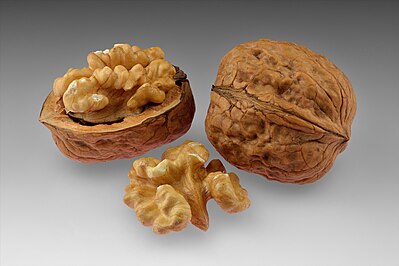
|
Walnuts are edible seeds taken from trees in the genus Juglans. The three species most commonly grown for their seeds are J. regia, originating from Iran, from which the Persian (or English) walnut is harvested; J. nigra, the black walnut tree, native to eastern North America; and J. ailantifolia, the Japanese walnut, also known as the heartnut. Numerous walnut cultivars have been developed commercially, nearly all of which are hybrids of the English walnut. They are often eaten as a snack, and can also be added to cooked meals, cereals and bread. Photograph credit: Ivar Leidus
Recently featured:
|
June 14
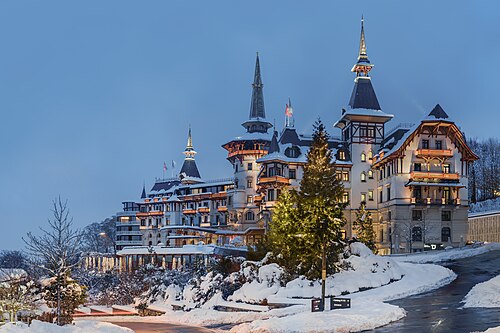
|
|
The Dolder Grand is a five-star hotel in the Swiss city of Zürich. It is located on Adlisberg, a hill some 2 kilometres (1.2 mi) from, and 200 metres (660 ft) above, the city centre. Built in 1899, the hotel is spread out over 40,000 square metres (430,000 sq ft) and offers 173 rooms and suites, two restaurants, a bar, thirteen conference rooms and a 4,000-square-metre (43,000 sq ft) spa. This photograph of the Dolder Grand in the snow was taken in January 2021. Photograph credit: Roy Egolff
Recently featured:
|
June 15
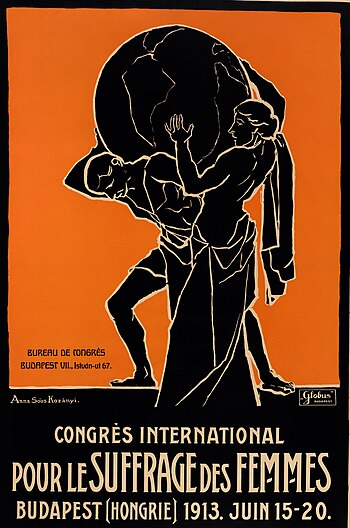
|
The Seventh Conference of the International Woman Suffrage Alliance met in Budapest, Hungary, from 15 to 21 June 1913. As had been the case with all the preceding conferences, the location had been chosen to reflect the status of women's suffrage: a place where the prospects seemed favorable and liable to influence public sentiment by demonstrating that it was now a global movement. When it had been announced at the sixth congress (in Stockholm) that the next one would be held in the capital of Hungary, it was felt that the location seemed very remote, and there were concerns that Hungary did not have representative government. In fact, it proved to be one of the largest and most important conventions. Furthermore the delegates stopped en route for mass meetings and public banquets in Berlin, Dresden, Prague and Vienna, spreading its influence ever further afield. This poster for the conference, designed by Anna Soós Korányi and now in the collection of the French Union for Women's Suffrage, depicts a woman helping Atlas hold up a globe on his shoulders. Poster credit: Anna Soós Korányi; restored by Adam Cuerden
Recently featured:
|
June 16

|
Jasper Francis Cropsey (1823–1900) was an American landscape artist, part of a movement known as the Hudson River School. Cropsey was trained as an architect, and worked on Manhattan brownstones, the since-demolished 14th Street station for the IRT Sixth Avenue Line in Manhattan, and St. Luke's Episcopal Church on Staten Island. In addition to architecture, Cropsey also studied watercolor painting and figure drawing, exhibiting his work at the National Academy of Design from 1844. In 1866, he opened a studio in New York, specializing in autumnal landscape paintings of the northeastern United States, often idealized and with vivid colors. Cropsey co-founded, with ten fellow artists, the American Society of Painters in Water Colors in 1866. He is seen here in a circa-1870 photograph by American lithographer and photographer Napoleon Sarony. Photograph credit: Napoleon Sarony; restored by Adam Cuerden
Recently featured:
|
June 17

|
The redhead (Aythya americana) is a medium-sized species of diving duck. The scientific name is derived from the Greek aithuia, an unidentified seabird mentioned by authors including Hesychius and Aristotle, and Latin americana, 'of America'. It belongs to the genus Aythya, together with eleven other described species. The redhead and the common pochard form a sister group which together is sister to the canvasback. This redhead was photographed in Central Park, New York. Photograph credit: Rhododendrites |
June 18

|
The Boeing KC-46 Pegasus is an American military aerial refueling and strategic military transport aircraft developed by Boeing from the Boeing 767 jet airliner. In February 2011, the tanker was selected by the United States Air Force (USAF) as the winner in the KC-X tanker competition to replace older Boeing KC-135 Stratotankers. The first aircraft was delivered to the USAF in January 2019, and it intends to procure 179 Pegasus aircraft by 2027. In this photograph, a KC-46A Pegasus refuels a Lockheed Martin F-35 Lightning II over California. Photograph credit: Ethan Wagner |
June 19
|
Tannhäuser is an 1845 opera in three acts, with music and text by Richard Wagner. It is based on two German legends: Tannhäuser, the mythologized medieval German Minnesänger and poet, and the tale of the Wartburg song contest. The story centres on the struggle between sacred and profane love, as well as redemption through love, a theme running through most of Wagner's work. This undated set design for Act III of a production of Tannhäuser was produced by Max Brückner and his brother Gotthold, and printed by Otto Henning AG in Greiz. Set design credit: Max and Gotthold Brückner; restored by Adam Cuerden
Recently featured:
|
June 20

|
Ilan Ramon (June 20, 1954 – February 1, 2003) was an Israeli fighter pilot and later the first Israeli astronaut. Ramon was a Space Shuttle payload specialist on STS-107, the final mission of Space Shuttle Columbia, in which he and the six other crew members were killed when the spacecraft disintegrated during re-entry. At the age of 48, he was the oldest member of the crew. Ramon is the only foreign recipient of the Congressional Space Medal of Honor, which he was awarded posthumously by the United States Congress. This official NASA portrait of Ramon, wearing an Advanced Crew Escape Suit, was taken in 2001. Photograph credit: NASA
Recently featured:
|
June 21
|
The Jane Byrne Interchange (previously known as the Circle Interchange) is a major freeway interchange in Chicago, in the U.S. state of Illinois. Located just outside the Chicago Loop, it is the junction between the Dan Ryan Expressway, the Kennedy Expressway, the Eisenhower Expressway, and the Ida B. Wells Drive. In a dedication ceremony held on August 29, 2014, the interchange was renamed in honor of Jane Byrne, a former mayor of Chicago. This video shows a moving aerial view of traffic on the Jane Byrne Interchange, shortly before the completion of a reconfiguration of the junction that was begun in 2013. Video credit: Sea Cow
Recently featured:
|
June 22

|
Bandits' Roost, 59 1/2 Mulberry Street is a black-and-white photograph produced by the Danish-American photographer and social reformer Jacob Riis in 1888. It is not known whether the photograph was taken by Riis himself, or by one of his assistant photographers, Henry G. Piffard and Richard Hoe Lawrence. It was first published in the photographic book How the Other Half Lives in 1889, which aimed to document the social conditions of the poorest people of New York City. The photograph was taken in The Bend, a dangerous and poor alley in Mulberry Street, New York City, which had a predominantly Italian population at the time, and was known for its high crime rates. Riis's social activism in pursuit of better life conditions for the poorest classes of New York, of which the book where this picture was published was one of the best examples, was one of the factors that led to the demolishment of Mulberry End, which was later replaced by a park. Photograph credit: Jacob Riis; restored by Adam Cuerden
Recently featured:
|
June 23

|
|
Cerussite is a mineral consisting of lead carbonate (PbCO3), and is an important ore of lead. The name is from the Latin cerussa, white lead. Cerussa nativa was mentioned by Conrad Gessner in 1565, and in 1832 François Sulpice Beudant applied the name céruse to the mineral, while the present form, cerussite, is due to Wilhelm Karl Ritter von Haidinger in 1845. Miners' names for cerussite in early use were lead-spar and white-lead-ore. In a hydrate form known as white lead, the mineral is a key ingredient in lead paints and has also been used in cosmetics, but both uses are now discontinued in many places as a result of lead poisoning. These cerussite crystals, measuring approximately 4.0 cm × 3.0 cm × 2.0 cm (1.57 in × 1.18 in × 0.79 in), were found in a mine in Madan-e Nakhlak, Iran. Photograph credit: Ivar Leidus
Recently featured:
|
June 24

|
Södermanland Runic Inscription 113 is a 10th-century runic inscription engraved on a 0.9 m by 0.5 m (35 in by 20 in) granite runestone in Södermanland, Sweden. The runestone was found in 1856 on a hill believed to have once had many other graves and monuments, and is thought to have originally stood atop a burial mound before falling over and being buried. The inscription is written in Old Norse using the Younger Futhark alphabet, and reads (transliterated into the Latin script): Þaiʀ situ stin, suniʀ Þurkitils auk Fulku, hiar faþur auk muþur iftiʀ. Kiarþu trikila, meaning: 'They placed the stone here, the sons of Þorketill and Folka, in memory of their father and mother. Made valiantly.' This photograph of the inscription was taken by Otto von Friesen, who owned the runestone in the early 20th century. Photograph credit: Otto von Friesen, restored by Adam Cuerden
Recently featured:
|
June 25
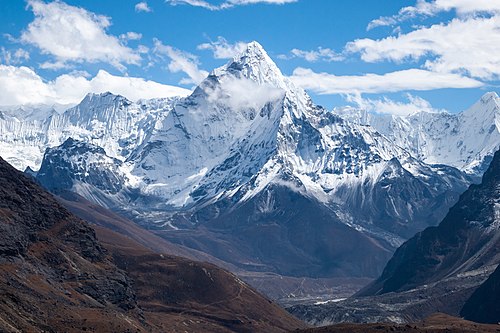
|
|
Ama Dablam is a mountain located in the eastern Himalayas in Koshi Province, Nepal. The main peak is at an elevation of 6,812 metres (22,349 feet) above sea level, and the lower western peak is at 6,170 metres (20,243 feet). The name means 'mother's necklace' in Sherpa; the long ridges on each side are thought to resemble the arms of a mother (ama) protecting her child, and the hanging glacier is the dablam, the traditional double-pendant containing pictures of the gods and worn by Sherpa women. For several days, the mountain dominates the eastern sky for trekkers to South Base Camp on Mount Everest. Due to its soaring ridges and steep faces, Ama Dablam is sometimes referred as the "Matterhorn of the Himalayas". The mountain is featured on the Nepalese one-rupee banknote. This photograph of Ama Dablam as seen from Chola Valley was taken in October 2009. Photograph credit: Vyacheslav Argenberg
Recently featured:
|
June 26

|
C/1881 K1 (also called the Great Comet of 1881) is a long-period comet discovered by Australian amateur astronomer John Tebbutt on 22 May 1881 at Windsor, New South Wales. It is called a great comet because of its brightness at its last apparition. This drawing of the comet, based on an observation on the morning of 26 June 1881, was made by Étienne Léopold Trouvelot. Drawing credit: Étienne Léopold Trouvelot
Recently featured:
|
June 27

|
|
The pomegranate (Punica granatum) is a fruit-bearing deciduous shrub in the family Lythraceae, subfamily Punicoideae, that grows between 5 and 10 m (16 and 33 ft) tall. The pomegranate was originally found only throughout the Mediterranean region. It was introduced into Spanish America in the late 16th century and into California by Spanish settlers in 1769. Photograph credit Ivar Leidus
Recently featured:
|
June 28

|
Avril de Sainte-Croix (1855–1939), also known by the pen name Savioz, was a French author, journalist, feminist and pacifist. For many years she led the French branch of the International Abolitionist Federation, which sought to abolish state regulation of prostitution and fought trafficking in women. She advised the French government and the League of Nations on women's issues. She was vice-president of the International Council of Women from 1920 and President of the National Council of French Women from 1922 to 1932. This photograph of de Sainte-Croix was taken by French photographer Henri Manuel in 1925. Photograph credit: Henri Manuel; restored by Adam Cuerden
Recently featured:
|
June 29
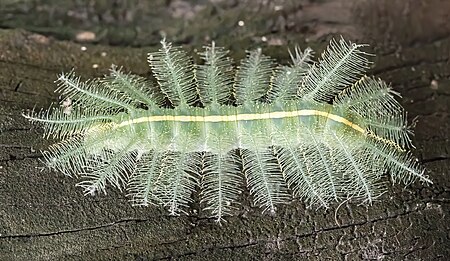
|
|
Euthalia aconthea, also known as the common baron, is a medium-sized species of butterfly in the family Nymphalidae native to south and south-east Asia. In 1905, Charles Thomas Bingham recorded it to be found throughout peninsular India, except in the desert tracts, and the higher ranges of the Himalayas; Assam; Burma; Tenasserim, extending to the peninsula, and Sumatra. This E. aconthea caterpillar was photographed on Don Det, an island in the Mekong, and part of Si Phan Don, an archipelago in southern Laos. Photograph credit: Basile Morin
Recently featured:
|
June 30
|
La bohème is a four-act opera composed by Giacomo Puccini between 1893 and 1895 to an Italian libretto by Luigi Illica and Giuseppe Giacosa, based on Scènes de la vie de bohème (1851) by Henri Murger. The story is set in Paris around 1830 and shows the Bohemian lifestyle of a poor seamstress and her artist friends, with romantic entanglements conflicting with the ever-present need of money to survive. In Act II, set in the Quartier Latin, Musetta, a singer, pushes the bill for the group of friends' extravagant meal onto her elderly patron (who tries and fails to have a romantic date with her), after resparking her tulmultuous relationship with Marcello. This set design for Act II of La bohème was created by the German artist Adolfo Hohenstein for the world premiere in Turin on 1 February 1896. Produced with India ink and tempera on paper, the illustration is in the archives of the Italian music publishing house Casa Ricordi. Set design credit: Adolfo Hohenstein; restored by Adam Cuerden
Recently featured:
|
Picture of the day archives and future dates
